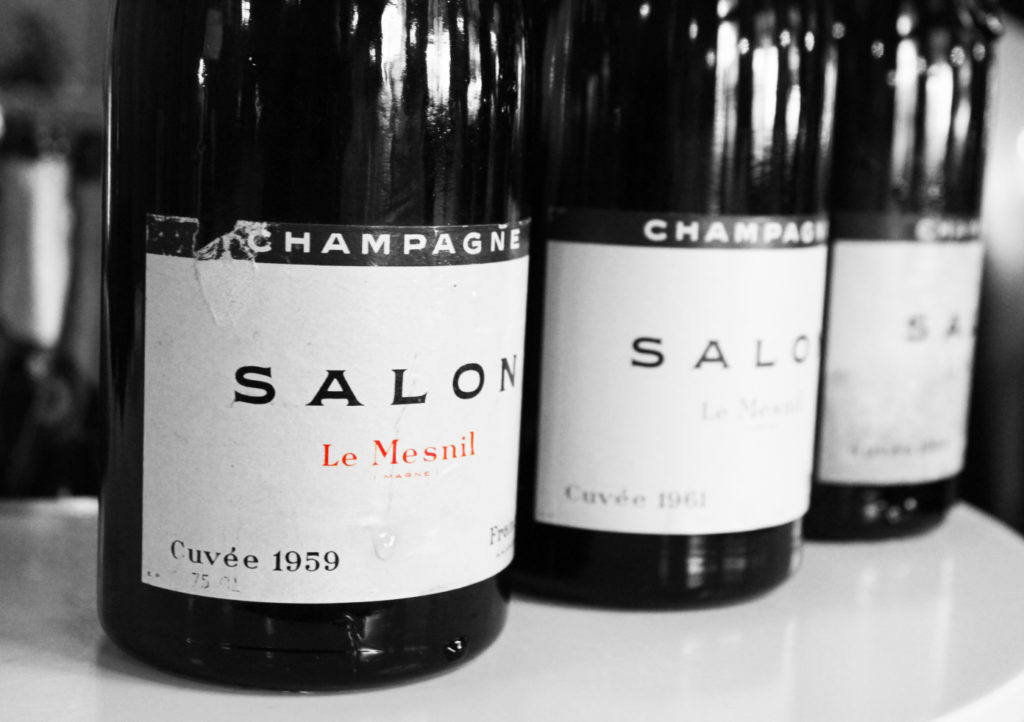10 PEOPLE – 24 CHAMPAGNES
VINTAGES
1949 -1948 – 1947
1953 – 1955 –
1959 – 1961 – 1964
1966 – 1969 – 1971
1973- 1976 – 1979
1982 – 1983 – 1985
1988 – 1990 – 1995
1996 – 1997 – 1999
2002 – 2004 – 2006
2007 – 2008 – 2012
RJ ON SALON Salon is the most sought-after Champagne among connoisseurs. This magnificent wine is so rare that only a few people have had the chance to taste the quintessence of Le Mesnil.
In 1867 a perfectionist by the name of Aimé Salon was born. He grew up in Champagne and dreamed of creating the perfect champagne at an early age. After a short period as a teacher he became a successful fur trader, which gave him the capital he needed to buy two small vineyards covering a total of one hectare in Le Mesnil.
He made his first champagne in 1911 and formed a Champagne house in 1914. As early as 1920, Salon became the house wine at the legendary Parisian restaurant, Maxim’s. Salon was the first commercial blanc de blancs, and a mono-cru besides. It’s quite remarkable that the fame and praise heaped upon the firm has continued through the years, as the big names see Salon’s philosophy as a direct antithesis of theirs.
In principle Salon is a grower champagne, in the sense that the wine contains only one kind of grape from just one cru. Salon may well be the best “grower“ of all, but the success of Selosse, Peters, Diebolt, and Charlemagne shows that they are all on the right course after all. When even the masters of the blend – Krug – made a mono-cru champagne from Le Mesnil, it became arder for the major companies to sing the praises of blending in such a dogmatic fashion. After Aimé died in 1943, the firm stayed within the family until 1963, when Besserat de Bellefon took over the show.
In 1989 Salon was bought by Laurent-Perrier, and today the firm is run by the infinitely charming and pleasant Didier Depond, who once worked for Laurent-Perrier. Recently the oak barrels have been thrown out, but that hardly affects the flavor, as the Le Mesnil Chardonnay grapes take up the most nutty and toasty aromas you can imagine, without even having seen an oak cask. Salon’s two plots in the village are always the ones where the leaves come out first, which shows that the microclimate there is exceptional. The average age of the vines is around fifty years old, and the other 75 percent of the grapes needed are chosen each year from the best growers in the village.
Salon demands longer cellaring than any other champagne. The wines do not go through malolactic fermentation and have a razor-sharp acidity in their youth, which carries the wine to unparalleled heights through the years. A mature Salon expresses a gigantically broad aromatic spectrum, and has a Burgundy-like vinosity. The stringency is maintained throughout the wine’s life, and as Salon has almost no dosage, the wine never becomes an exotic charmer like Taittinger Comtes de Champagne, but it is unmatched in terms of class and purity. Salon is only made in exceptionally good years, and in other years the grapes go to make up Delamotte.
Since 1921 the following vintages have been produced: ’21,’25, ’28, ’34, ’37, ’43, ’45, ’46, ’47, ’48, ’49, ’51, ’52, ’53, ’55, ’59, ’61, ’64, ’66, ’69, ’71, ’73, ’76, ’79, ’82, ’83, ’85, ’88, ’90, ´95, ´96, ´97 , ´99, ´02, ´04, ´06, ´07 and the absolutely brilliant 2008 in magnum.
DETAILS will be updated on prices & how to book this world-class event at a later stage.

